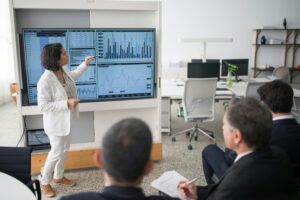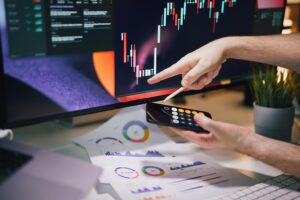Introduction: Understanding The Modern &Future Market Revolution
The Market Revolution has entered a new era. Unlike the historical revolution of the 18th and 19th centuries—which brought about industrialization, mechanized labor, and rapid urbanization—the Modern & Future Market Revolution is defined by digital innovation, artificial intelligence, and a shift toward sustainable economies.
Today’s Market Revolution is happening at a global scale and at unprecedented speed. It’s reshaping how businesses operate, how people work, and how consumers make decisions. From automation and big data to the rise of the gig economy and decentralized finance, every sector is undergoing transformation.
Understanding this new phase of the Market Revolution is crucial. It empowers individuals, businesses, and governments to adapt to changing demands and seize emerging opportunities. Unlike revolutions of the past, which took decades to unfold, the modern transformation can shift entire industries in just a few years—or even months.
The Modern & Future Market Revolution is also driven by consumer expectations for speed, personalization, and transparency. Businesses must now be agile, tech-savvy, and socially responsible to remain competitive. In parallel, workers must embrace lifelong learning and digital skills to keep pace.
As we move deeper into the 21st century, this evolving revolution will continue to influence every part of society—from labor and education to trade and environmental policy. Recognizing the trends and responding proactively is not optional—it’s essential for survival and success.
From Industrial to Digital: How Markets Continue to Evolve
The Market Revolution has never been static; it continuously evolves to reflect technological advancements and shifting economic priorities. While the original Market Revolution was marked by the rise of industrialization, mechanized production, and transportation breakthroughs, the Modern & Future Market Revolution is characterized by digital transformation and the integration of cutting-edge technologies.
The shift from industrial to digital markets represents a fundamental change in how goods and services are produced, distributed, and consumed. Unlike traditional industrial markets focused on physical manufacturing and centralized production, today’s markets emphasize data, automation, and connectivity.
Key drivers of this evolution include:
-
Automation and AI: Robots and intelligent algorithms now handle many tasks that once required human labor, from assembly lines to customer service. This increases efficiency but also reshapes the workforce.
-
E-commerce and Digital Platforms: Online marketplaces have revolutionized retail, creating global access and personalized shopping experiences that were unimaginable during the industrial era.
-
Big Data and Analytics: Companies leverage vast amounts of data to predict trends, understand consumer behavior, and optimize operations, shifting decision-making from intuition to evidence-based strategies.
-
Remote Work and Gig Economy: The rise of remote work and freelance platforms reflects how digital markets prioritize flexibility and decentralized labor models.
This ongoing evolution is not just about technology; it also reflects new economic and social values such as sustainability, inclusivity, and innovation. The Modern & Future Market Revolution demands agility from businesses and workers alike, making adaptability a key success factor.

Key Drivers Behind the Modern Market Revolution
The Modern & Future Market Revolution is not a single event but a complex, ongoing shift driven by powerful forces that are reshaping industries, economies, and societies worldwide. Understanding the key drivers behind this revolution is essential to navigating and thriving in today’s fast-paced global marketplace.
1. Technological Innovation
At the heart of the modern Market Revolution is technology. Advancements in artificial intelligence (AI), robotics, machine learning, blockchain, and quantum computing are transforming how products are made, services are delivered, and decisions are made.
-
AI and Automation have streamlined everything from manufacturing to customer service.
-
Blockchain is decentralizing finance and improving data transparency.
-
Cloud computing allows businesses to scale and innovate faster.
2. Global Digital Connectivity
The internet and mobile technology have connected the world in real-time. This digital infrastructure enables businesses to reach global audiences, workers to collaborate across continents, and consumers to access services instantly.
-
5G networks enhance communication speed.
-
Remote work platforms like Zoom and Slack enable decentralized workforces.
3. Shifts in Consumer Behavior
Modern consumers expect speed, personalization, and social responsibility. The modern Market Revolution is being shaped by individuals who demand ethical sourcing, eco-friendly products, and seamless digital experiences.
-
Brands are now judged on values, not just price.
-
E-commerce has replaced traditional shopping habits.
4. The Rise of the Gig and Freelance Economy
The traditional 9-to-5 job is evolving. More individuals are choosing flexible, project-based work over full-time employment, fueling platforms like Upwork, Fiverr, and Uber.
-
This model provides freedom and flexibility but also presents challenges around income stability and benefits.
5. Sustainability and ESG (Environmental, Social, Governance)
Businesses are no longer judged solely on profits. Sustainability and ethical governance are becoming core market demands. Companies that invest in renewable energy, reduce waste, and support social causes are gaining customer trust.
-
Governments are also encouraging green innovation through incentives and policies.
The Role of Artificial Intelligence and Automation
Artificial Intelligence (AI) and automation are two of the most powerful forces driving the Modern & Future Market Revolution. These technologies are not only transforming industries but also redefining how we work, interact, and consume in the global economy.
Revolutionizing Work and Productivity
AI and automation are streamlining tasks across every sector:
-
Manufacturing uses robotics to increase speed and precision.
-
Healthcare leverages AI to assist with diagnoses and personalized treatments.
-
Finance benefits from automated trading, fraud detection, and AI-driven customer support.
These technologies reduce human error, boost efficiency, and lower operational costs—core elements of the ongoing Market Revolution.
Creating New Job Categories
While automation replaces some routine jobs, it also creates new roles in areas like data analysis, AI programming, and robotics maintenance.
-
Demand for skills in machine learning, AI ethics, and cybersecurity is on the rise.
-
The workforce is shifting toward jobs that require creativity, problem-solving, and human interaction—skills that machines can’t replicate.
Transforming Customer Experience
AI powers the personalized experiences that modern consumers expect:
-
Chatbots and virtual assistants offer 24/7 support.
-
Recommendation engines on platforms like Amazon and Netflix enhance user engagement.
-
AI can even predict customer behavior to anticipate needs before they arise.
These innovations help businesses stay competitive in a rapidly evolving Market Revolution.
Ethical Considerations and Future Risks
As AI and automation expand, so do concerns about:
-
Data privacy
-
Algorithmic bias
-
Job displacement
Businesses and governments must ensure these tools are used responsibly to promote trust and social stability in the future marketplace.
The Gig Economy and Decentralized Workforces
One of the most defining features of the Modern & Future Market Revolution is the rapid rise of the gig economy and decentralized workforces. These shifts are transforming how people engage with work, challenging traditional employment models, and reshaping global economic structures.
What Is the Gig Economy?
The gig economy refers to a labor market where short-term contracts, freelance work, and on-demand jobs replace traditional full-time employment. Powered by digital platforms like Uber, Fiverr, and Upwork, gig workers can now offer services on a flexible schedule, often from anywhere in the world.
- Freelancers, rideshare drivers, delivery personnel, and consultants all fall under this category.
- Workers often juggle multiple gigs to maintain income flexibility.
The Shift Toward Decentralized Workforces
Decentralized workforces mean employees and freelancers are no longer tied to a central physical location. Enabled by remote work technologies, teams now collaborate across cities, countries, and continents.
This decentralization brings many benefits:
- Cost savings for companies (less office space).
- Greater access to global talent.
- Increased work-life balance for employees.
Impact on the Market Revolution
The shift to gig and remote work reflects broader trends in the Modern & Future Market Revolution, including:
- The digital transformation of business models.
- Rising worker demand for flexibility and autonomy.
- Businesses using AI and platforms to manage distributed teams and optimize tasks.
These trends emphasize agility, innovation, and responsiveness in today’s economic environment.
Challenges and Considerations
Despite its advantages, the gig economy comes with challenges:
- Lack of traditional job benefits (healthcare, retirement).
- Income instability for gig workers.
- Unclear legal protections in some regions.
Governments and businesses must adapt policies to support fair labor practices in this evolving landscape.
How Consumer Behavior is Transforming Modern Market
Consumer behavior is at the heart of the Modern & Future Market Revolution, driving rapid shifts in how businesses operate, innovate, and compete. Today’s consumers are more informed, connected, and empowered than ever, and their evolving preferences are reshaping entire industries.
The Rise of Digital-First Preferences
Modern consumers expect convenience, speed, and personalized experiences—often delivered through digital platforms. Online shopping, mobile apps, and AI-driven product recommendations are now standard, forcing companies to rethink how they engage with customers.
- Customers want 24/7 access to products and services.
- Brands must offer seamless digital experiences across devices.
- Real-time communication through chatbots or social media is becoming the norm.
Demand for Ethical and Sustainable Choices
More than ever, consumers care about how and where products are made. They seek transparency, ethical sourcing, and environmental responsibility, prompting businesses to adapt.
- Sustainability has become a competitive advantage.
- Labels like “organic,” “cruelty-free,” and “carbon neutral” influence buying decisions.
- Companies are expected to be socially responsible and transparent.
Personalization and Data-Driven Experiences
The Modern & Future Market Revolution is powered by data. Consumers now expect brands to understand their preferences and tailor experiences accordingly.
- AI and machine learning deliver personalized recommendations.
- Targeted marketing campaigns improve engagement and sales.
- Subscription-based models cater to individual tastes and habits.
The Shift Toward Experiential Value
Consumers are increasingly valuing experiences over ownership. This shift has led to the growth of service-based models and the experience economy.
- Streaming services, ride-sharing, and travel experiences are booming.
- Brands focus on creating emotional connections and memorable moments.
- “Try-before-you-buy” and immersive digital previews enhance decision-making.
Conclusion
As part of the Modern & Future Market Revolution, changes in consumer behavior are not just influencing what people buy—but how, when, and why they buy it. Businesses that understand and adapt to these shifts will thrive in this dynamic landscape. Those that fail to evolve risk falling behind in an increasingly competitive and consumer-driven economy.
Let me know when you’re ready for the next section!
The Impact of Globalization on the Future Market Revolution
The Modern & Future Market Revolution is deeply intertwined with the ongoing forces of globalization. As borders become more economically porous and technology bridges distant markets, globalization accelerates how industries evolve and how businesses reach consumers worldwide. This interconnectedness is shaping not just current market conditions but the very future of commerce, labor, and innovation.
1. Expanded Market Access and Competition
Globalization allows businesses—big and small—to enter international markets with fewer barriers than ever before. This results in increased competition, better pricing, and more choices for consumers.
Key Impacts:
- Small businesses can scale globally via digital platforms.
- Consumers access a broader range of products from across the world.
- Global competition encourages innovation and efficiency.
2. Outsourcing and Global Labor Shifts
The Modern & Future Market Revolution continues to rely on labor shifts enabled by globalization. Outsourcing manufacturing and services to countries with lower labor costs has become a norm—but it’s evolving.
Key Impacts:
- A rise in “nearshoring” to reduce supply chain vulnerabilities.
- Increased use of remote and freelance global workers.
- Ethical labor practices are under greater scrutiny.
3. Supply Chain Transformation
Globalization pushes companies to develop more agile, tech-driven supply chains. In the face of global disruptions like pandemics or conflicts, resilient supply chains are now a key priority.
Key Impacts:
- Adoption of AI and blockchain for real-time tracking.
- Diversification of suppliers to mitigate risk.
- Focus on sustainability and local sourcing when possible.
4. Cultural Convergence and Localization
While globalization spreads trends and products quickly, it also demands sensitivity to local cultures and preferences. Successful brands adapt their offerings to meet regional tastes.
Key Impacts:
- Localized marketing strategies are essential.
- Language and cultural understanding impact product success.
- Global brands partner with local influencers to build trust.
5. Technology as a Global Equalizer
Access to affordable internet and mobile devices has brought millions into the global economy. In developing regions, technology is enabling entrepreneurs and consumers to leapfrog into the digital age.
Key Impacts:
- Fintech is empowering the unbanked with mobile wallets.
- E-learning and remote work create new job opportunities.
- Innovation is emerging from all corners of the globe.
Conclusion
Globalization is not a side effect—it’s a major engine driving the Modern & Future Market Revolution. As markets merge and digital tools bring global access within reach, the future of commerce will be shaped by collaboration, competition, and cross-cultural understanding. Businesses that embrace globalization while adapting to its challenges will lead in tomorrow’s economy.
Let me know if you’d like the next section or help formatting this for WordPress.
Conclusion: What the Future Market Revolution Means for Us All
The Modern & Future Market Revolution is not just a trend—it’s a transformative shift redefining how we live, work, and interact with the economy. From automation and AI to global connectivity and shifting labor norms, this revolution touches every aspect of society.
Whether you’re an entrepreneur, employee, policymaker, or consumer, understanding the implications of these changes is crucial for staying ahead in an increasingly dynamic world.
1. A Workforce in Transition
The nature of work is rapidly evolving. Remote jobs, freelance platforms, and AI-driven roles are reshaping employment across the globe.
What this means for us:
- Lifelong learning will become the norm.
- Soft skills like adaptability and problem-solving will be in high demand.
- Workers must embrace digital tools to remain competitive.
2. Shifting Consumer Power
Consumers today have more information, more choices, and more influence than ever before. Their expectations are reshaping industries and forcing companies to become more transparent, ethical, and responsive.
What this means for us:
- Brands must build trust through values and action.
- Customization and personalization will drive future sales.
- Consumers will influence supply chains, sustainability, and innovation.
3. Economic Opportunities and Challenges
The Modern & Future Market Revolution presents both immense potential and real risks. While technology opens new markets and efficiencies, it also risks increasing inequality if not managed wisely.
What this means for us:
- There’s a chance to create inclusive growth through tech access.
- Policymakers must rethink regulation, education, and taxation.
- Societies must balance innovation with fairness.
4. Global Interdependence
In today’s market, events in one region can ripple across the globe. Climate change, trade policies, and geopolitical tensions all influence supply chains and economic growth.
What this means for us:
- Collaboration between nations and businesses will be vital.
- Global awareness is no longer optional—it’s essential.
- Local actions can have worldwide economic impacts.
FAQ – The Modern & Future Market Revolution
Understanding the Modern & Future Market Revolution can be overwhelming due to the pace of change in technology, economy, and consumer behavior. Below are some frequently asked questions to help break it down in a clear, simple, and informative way.
What is the Modern & Future Market Revolution?
The Modern & Future Market Revolution refers to the ongoing transformation of global markets driven by advancements in technology, artificial intelligence, remote work, changing consumer preferences, and globalization. Unlike past revolutions, this one is digital, decentralized, and constantly evolving.
How does it differ from past market revolutions?
While the original Market Revolution was about mechanization and infrastructure, the modern version focuses on:
- Automation & AI
- Data-driven decision making
- E-commerce and gig work
- Decentralized finance (DeFi)
The Modern & Future Market Revolution is global in scale and much faster in pace due to digital connectivity.
What industries are most affected?
Nearly all industries are experiencing disruption, but the most affected include:
- Retail (shift to online)
- Manufacturing (automation and smart factories)
- Finance (cryptocurrencies and digital banking)
- Healthcare (AI diagnostics and telemedicine)
- Education (e-learning and remote access)
How does artificial intelligence play a role?
AI is at the core of the Modern & Future Market Revolution. It enhances productivity, automates tasks, improves customer experience, and powers data analytics.
Examples:
- Chatbots in customer service
- Predictive algorithms in marketing
- AI in logistics and supply chain
What is the impact on jobs and employment?
This revolution is reshaping work:
- Traditional jobs are evolving or disappearing.
- Gig work and freelancing are on the rise.
- Digital literacy is becoming a must.
- Remote work is more widespread than ever.
While some jobs are lost to automation, many new roles are emerging in tech, sustainability, and data science.
What does it mean for consumers?
Consumers are more empowered than ever:
- They expect fast, personalized service.
- They influence brands through reviews and social media.
- They demand ethical and sustainable practices.
The market is shifting to match these elevated expectations.
How can individuals prepare for the future market?
- Learn new digital skills regularly.
- Stay adaptable and open to change.
- Follow global economic trends and innovations.
- Invest in lifelong learning.
Being proactive and informed will help individuals thrive in the evolving landscape.
Final Thoughts
The Modern & Future Market Revolution is reshaping economies, industries, and personal lives. By understanding its core elements and preparing for its shifts, individuals and businesses can turn disruption into opportunity.
###
somsecret Business Marketing
laundromat Market Revolution







Nice share!